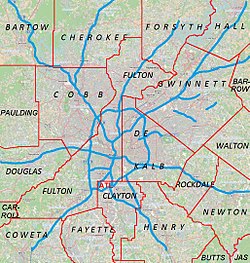
Clayton County is located in the north central portion of the U.S. state of Georgia. As of 2021, the population was estimated to be 297,100 by the Census Bureau. The county seat is Jonesboro.
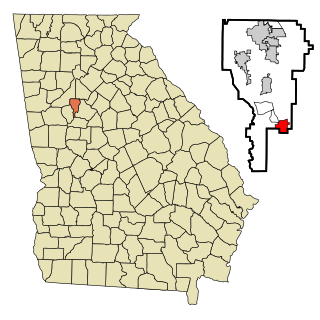
Lovejoy is a city in Clayton County, Georgia, United States. As of the 2010 census, the city had a population of 6,422, up from 2,495 in 2000. During the American Civil War, it was the site of the Battle of Lovejoy's Station during the Atlanta Campaign of 1864.

Sherman's March to the Sea was a military campaign of the American Civil War conducted through Georgia from November 15 until December 21, 1864, by William Tecumseh Sherman, major general of the Union Army. The campaign began on November 15 with Sherman's troops leaving Atlanta, recently taken by Union forces, and ended with the capture of the port of Savannah on December 21. His forces followed a "scorched earth" policy, destroying military targets as well as industry, infrastructure, and civilian property, disrupting the Confederacy's economy and transportation networks. The operation debilitated the Confederacy and helped lead to its eventual surrender. Sherman's decision to operate deep within enemy territory without supply lines was unusual for its time, and the campaign is regarded by some historians as an early example of modern warfare or total war.
The Battle of Lovejoy's Station was fought on August 20, 1864, near what is now Lovejoy, Georgia, in Clayton County, during the Atlanta Campaign of the American Civil War. The two sides had arrived at something of a stalemate, with the Union army half-encircling Atlanta and the Confederate defenders staying behind their fortifications.

The Battle of Jonesborough was fought between Union Army forces led by William Tecumseh Sherman and Confederate forces under William J. Hardee during the Atlanta Campaign in the American Civil War. On the first day, on orders from Army of Tennessee commander John Bell Hood, Hardee's troops attacked the Federals and were repulsed with heavy losses. That evening, Hood ordered Hardee to send half his troops back to Atlanta. On the second day, five Union corps converged on Jonesborough. For the only time during the Atlanta Campaign, a major Federal frontal assault succeeded in breaching the Confederate defenses. The attack took 900 prisoners, but the defenders were able to halt the breakthrough and improvise new defenses. Despite facing overwhelming odds, Hardee's corps escaped undetected to the south that evening.

Lamartine Griffin Hardman was an American physician and politician who served two terms as the 65th Governor of the state of Georgia from 1927 to 1931. He believed that state government should be run like a business and was best known for his effort to make governmental processes more efficient.
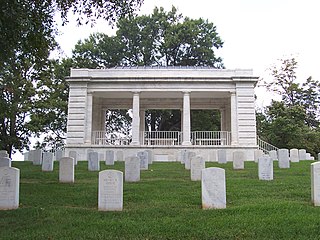
Marietta National Cemetery is a United States National Cemetery located in the city of Marietta in Cobb County, Georgia. It encompasses 23.3 acres (9.4 ha), and as of the end of 2006, had 18,742 interments. It is closed to new interments, and is now maintained by the new Georgia National Cemetery.
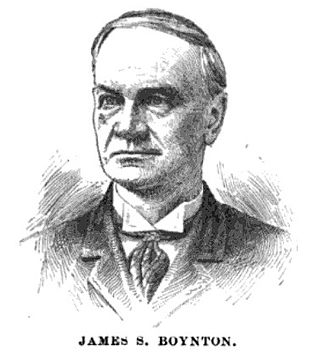
James Stoddard Boynton was an American politician and jurist.

Georgia was one of the original seven slave states that formed the Confederate States of America in February 1861, triggering the U.S. Civil War. The state governor, Democrat Joseph E. Brown, wanted locally raised troops to be used only for the defence of Georgia, in defiance of Confederate president Jefferson Davis, who wanted to deploy them on other battlefronts. When the Union blockade prevented Georgia from exporting its plentiful cotton in exchange for key imports, Brown ordered farmers to grow food instead, but the breakdown of transport systems led to desperate shortages.

Oconee Hill Cemetery is a cemetery in Athens, Georgia, United States. The extant cemetery opened in 1856 and is located near the University of Georgia.

The 38th Alabama Infantry Regiment was an infantry regiment that served in the Confederate Army during the American Civil War.
Events from the year 1864 in the United States.
Dorsey House may refer to:
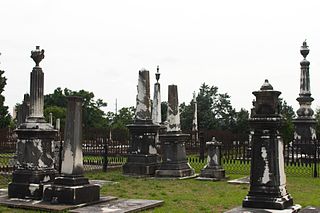
The Old City Cemetery, also known as Linwood Cemetery, is a 28.7-acre (11.6 ha) cemetery on what is now Linwood Boulevard, in Columbus, Georgia. It dates from 1828, when the town of Columbus was founded, or before. It appears in surveyor Edward Lloyd Thomas's original plan for the city. The cemetery consists mostly of rectangular family plots bordered by iron fences or walls made of brick or granite, accessed by a main east-west corridor and perpendicular lanes. It includes both simple and elaborate tombstones, some displaying Egyptian Revival or Gothic styles.
Flat Rock is a historic African American community in DeKalb County, Georgia. It is located within the city of Stonecrest, as well as the Arabia Mountain National Heritage Area. Flat Rock is believed to be one of the oldest African American settlements in DeKalb County. In 1820, the area rested along the border of Creek and Cherokee Nation hunting grounds when it was settled during the Georgia Land Lottery. In 1865, after the end of the Civil War, the era of reconstruction provided opportunity for former enslaved people to stay in the area to build schools, churches, and civic organizations and create the tight knit African American Flat Rock Community. The community has continued to live in the area and have experienced the Black Codes, Jim Crow and the Great Migration. The area currently houses the Flat Rock Archives, which specialize in preserving African American rural history in Georgia.

Georgia State Route 920 (SR 920) is a 17.1-mile (27.5 km) arterial road in the Metro Atlanta area in the state of Georgia. The route number is a temporary designation placed along the route while it is upgraded to be converted to be a future alignment of SR 81. It connects the county seat of Henry County, McDonough, to the seat of Fayette County, Fayetteville via SR 54. It is known locally as Jonesboro Street in the city limits of McDonough, Jonesboro Road in Henry County, and McDonough Road in Clayton and Fayette counties. In honor of the late founder of Chick-fil-A, the majority of the route is signed as the S. Truett Cathy Highway.

